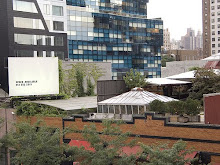

1) The baseball field constructed in the early 1950’s. 2009, Mike Ren. 2) Wall and entrance leading to Columbia University. 2009, Mike Ren.
Located between Harlem and Columbia University, Morningside Park has become a natural divider for the affluent white members of Columbia and the lower-class Black residents of Harlem. In the late 1960’s, the expansionistic qualities of the predominately white institution of Columbia created conflicts within the community by building a privatized facility on public land, disregarding Morningside Park’s social importance to Harlem residents. Organized protest and direct community involvement ensued in order to protect African-American rights. The events at the park quickly gained new meaning as a symbol of forcefully combating oppression and halting the freedom of white supremacy.
In the 1950s, the New York City Parks Departments allowed Columbia to build a privatized athletic baseball field at the southern end of Morningside Park, on the condition that the University open the field to community use on specific days with the correct supervision and permits. The Harlem residents resented this use of public land and limitations imposed for their use, but there was no direct opposition.
Having been granted relative freedom in creating the field, in 1961, Columbia once again started to exploit the public space. Led by Columbia’s President Grayson Kirk, the plan was to build a nine-story gymnasium by excavating a small portion of Morningside Park. Kirk and Robert Moses, the City Park Commissioner at the time, agreed upon the proposed construction, but on the condition that the gymnasium also allow community use due to its location on public land. It was agreed upon that out of the nine floors, two of the bottom floors would be accessible by the public. Although the plan was designed to benefit both the community and school, Harlem residents were frustrated they didn’t have a voice in the construction. Further more, minority community members saw the new gym as an act of segregation and racial discrimination as only the bottom two floors were designated for public use while the other six floors were for the affluent white students and faculty. Finally, facing overwhelming opposition in the form of neighborhood organized protest, blockages and picket lines, and eventually student occupations demanding construction to be halted, Columbia stopped construction.
The park today is still predominately occupied by Harlem residents. There have been many renovations within the park to make it more appealing to the public. Flowers, trees, and even new paved paths line up the west area of the park next to Columbia University. The baseball field is still in its spot, unoccupied by the public. The original site for the construction of the gymnasium has become a staircase leading up to Columbia.
Although the outcome turned favorable towards black power and student rights, there are issues that need to be address based out of the actions and unlimited opposition leading up to it. Prior to the protest and student occupations, President Kirk believed he had little to worry about in constructing the gym on public land. In effect, he was guaranteed that the state would follow the will of the university due to its distinguished status as an Ivy League University. It becomes a privilege for the wealthy white-owned University to access public land in the hands of minorities in order to further their own goals. In essence, without opposition from its own students, Columbia could have ignored the community due to the support of the white-privileged state.
Bibliography:
1. Bradley, Stefan M. Harlem vs Columbia University: Black Student Power in the Late 1960's. Chicago: University of Illinois, 2009. Print.
2. Crisis At Columbia. New York: Alfred A. Knopf Inc., 1968. Print.
3. Jerry, Avorn L., Jaffe Mark, Oren Root, Jr., Paul Starr, Michael Stern, and Robert Stulberg. Up Against the Ivy Wall: A History of the Columbia Crisis. Ed. Robert Friedman. Canada: McClelland and Stewart Ltd., 1968. Print.
4. Kahn, Roger. The Battle For Morningside Park: Why Students Rebel. New York: William Morrow and Company Inc., 1970. Print

No comments:
Post a Comment